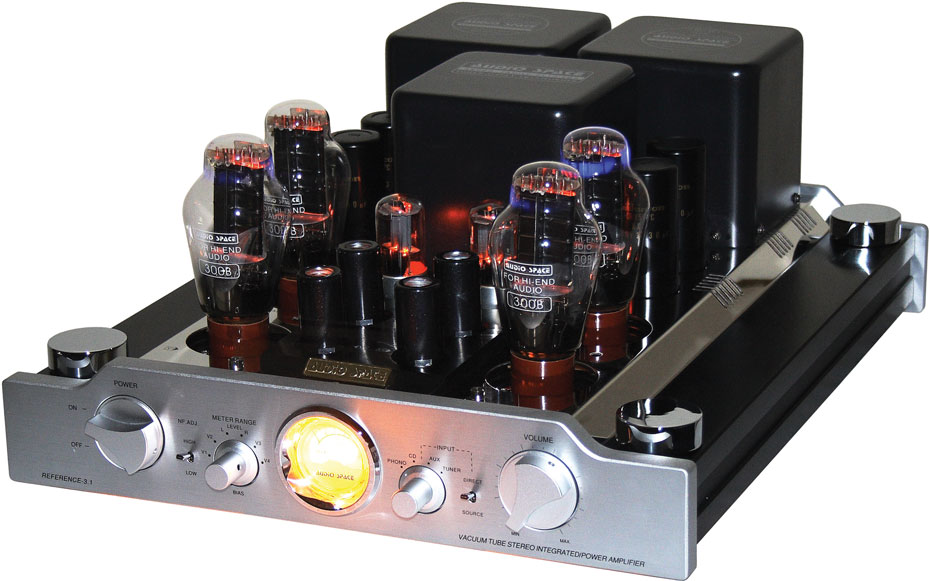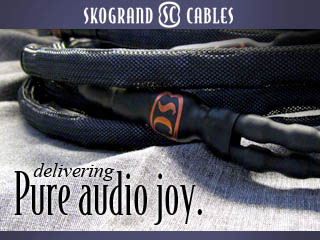
Two can be as bad as one
It’s the loneliest number since the number one”
–Three Dog Night
My tastes in amplification run counter to most. I love the relative strengths of tubes and transistors, and am constantly looking for products that bridge the gap. As much as I would love to go along with the crowd and embrace 5-watt triode amps, they just don’t work for me. I’m a “Full Frequency Response Recording” kind of guy, to borrow from Decca. I’m also a Full Dynamic Response Recording guy too. To date, I haven’t heard a system with 5-7 watts that had full frequency response or full dynamics. To make a speaker work with five watts means you’re maximizing efficiency at the expense of something else. Can it sound good? Sure it can, but only with a limited number of recordings.
One of the problems for the high-end is the dumbing-down of music, trying to set a list of criteria for music before it can be played on a system. I don’t know how to say it, but it’s just wrong. Are you guys really excited by boring music? Do you prefer Mozart to Shostakovich? Diana Krall to Big Brother and the Holding Company (Janis)? Three Blind Mice to Duke Ellington? What’s with the homogenated, boring music, folks? My goal is to find gear that can play as much music as possible, and the little flea-powered single-ended amps just don’t cut it.
Many tube gurus have decided that single-endedness is next to Godliness. Because single-ended amplifiers have an eastern-metaphysical-guru-God-like-cultish-hype surrounding them, most companies offer single-ended or parallel single-ended offerings. From my experience with ordinary parallel-push-pull amplifiers, it’s better to forego parallel devices because tubes are impossible to match. The resulting bias complications of parallel devices cause audible problems.
The big 845 and 211 single-ended amps have the power, but the complicated output transformers kill frequency response, introduce phase errors and coloration. Actually, output transformers are the problem. Good singled-ended output transformers are large, expensive, and take a lot of skill to build. Old fashioned PP pentodes/beam tetrodes definitely kick out the jams, but lack the nuance and subtleties we like with SE triodes.
The solution is obvious: push-pull triodes, preferably class A. One of the first amplifier patents was for a push-pull triode circuit. Western Electric’s high-end designs used push-pull triodes. What do you get when using push-pull triodes? Very low distortion without the use of big feedback, healthy output, and immunity from noise. Last time I checked, those were all good things. Unlike single-ended amps, you don’t have to choose between parafeed (with a nasty coupling cap between the plate and primary winding) or a large, compromised, air-gapped, output transformer.
There is a historical precedence, not just in the Western Electric amps, but in offerings like the Brook 10C, McIntosh MI200 and triode connected pentodes like the Williamson. Your choices are limited when you look for push-pull triode amps. Because there are relatively few PP triode amps available, it takes more looking. The Audio Space Reference 3.1 is one.
First of all, the build quality of the Audio Space Reference 3.1 is excellent. From the heft of the thing, you can tell it’s not a metal box full of air. The transformers are large, and while I don’t knowing what’s inside the potting enclosures, they give the impression of being well built units.
Out of the box, the Reference 3.1 is an excellent sounding unit. With only thirty minutes of warm-up, I was enjoying the music, bopping along to my favorite tunes. However, after extended listening I did start to notice a brightness that tended to push images forward and cause a little listener’s fatigue. It was actually less noticeable with digital sources, probably because there is less high frequency information with digital. When I switched from the charming Deft II cartridge, which is a picture of simplicity, to the ultra detailed Audio Technica AT150MLX, it became even clearer that there were some issues with the high frequencies. Playing with the feedback control significantly improved the problem, but at the expense of lost information, sluggishness and reduced dynamic range. I had a hunch. Could it be that all the problems I was hearing was because the tubes sucked? Hmmmmmm……
The weakest link
The following section is addressed not to Audio Space, or other equipment manufacturers, but to vacuum tube producers, the guys who actually make vacuum tubes. The current quality of octal and 9-pin miniature preamp tubes is very poor. Whoever produced the 12ax7 used in the Audio Space amp is less than competent. When I pulled the 12ax7 to try different tubes, one of the tubes was stuck, and it took an extraordinary amount of effort to remove it. I soon found out that the pin spacing on one tube was off by as much as .025” as I measured from pin to pin. It was so bad that you could see where the tube pins were splayed out to conform to the socket as they were seated. Some glass chipped off where the pin entered the base of the tube. This isn’t the fault of the tube socket or Audio Space, as the sockets themselves were fine; injection molding machines are very consistent. Also, the pins were .035” longer than a GE and .045” longer than a Telefunken! When tubes were being produced in the ‘50s, you never saw poor quality like this.
To be fair though, the Chinese power tubes are quite good. In my experience, most of the Chinese 300Bs sound as good, or slightly better, than the JJ 300B which is a very popular tube. As long as a 300B is pumped long enough to get a hard vacuum, which isn’t a foregone conclusion, the tube should sound good. The 300B, and similar tubes, are relatively easy to build. There are no exotic materials or difficult structures. Compared to a frame grid tube, the grid of a 300B is a breeze to produce. A directly heated triode is a thing of simplicity when compared to an EL34 or 6550. It’s crazy that new production triodes are more expensive than a well made 6550. Oh well, it is what it is! If you want to buy really good power tubes, I’d turn to Kron or Emission Labs. I don’t know much about the Takatsuki tubes, but I trust Japanese manufacturing’s commitment to quality more than European, American or other Asian manufacturers. From my experience with Chinese, Russian and JJ 300B, these are again above average and of very good quality.
To see if some of the fancy Chinese 9-pin and octal tubes were made to a higher standard, and hopefully find an affordable new production tube, I wrote to a well known importer of Chinese tubes and equipment based in Canada. When I asked about getting samples of the high-end 9-pin and octal tubes, I was informed that they no longer provide review samples because the Chinese factories do not honor distribution agreements and North American buyers merely purchase from China through eBay. Of course, if you are selling a dressed up $25 tube for $100, then you drive buyers to look for “bargains.” But, when buyers look for bargains on eBay, there is no guarantee they aren’t buying factory seconds, or thirds, or worse. Well, I think that pretty much sums up doing business with the Chinese vacuum tube manufacturers: sometimes shoddy construction, sometimes bad sound and many times bad business practices. Are all manufacturers the same? I hope not, but I have yet to hear a good Chinese 12ax7, 6sn7 or any other small preamp tube.
So, if you do buy the Audio Space 3.1, keep the stock 300B’s which are very good, and throw the rest in the trash. Don’t even keep them for spare parts. They are vacuum tubes only in the sense that they are tubular and almost have a vacuum inside them. Instead, go to eBay and buy some decent RCA, Sylvania, GE, etc. You don’t need the most expensive or most awesome tubes to sound good in the 3.1. Because of the circuit, any decent 12ax7 or 6sn7 will sound good. Some tube types, the 6dj8 for example, can sound dramatically different from manufacturer to manufacturer, and sample to sample. The 6sn7 and 12ax7 keep a fairly similar sound across the various makes and versions. Are there lesser versions of those tubes? Sure.
To see how bad the Chinese 12ax7s were, I put in a set of cheap, used, untested, dirty, GE 12ax7s, with visibly fading getters. They sounded better. One of the four tubes had some gas, so I threw that one it in the trash. The replacement was quiet. Next, I tried four borderline weak Telefunken 12ax7 that tested good for gas and shorts, and were below the 200 that was “good” on my Hickok tester. How did they sound compared to the Chinese 12ax7? Like the difference between a Cummins Diesel (Chinese) and a Ferrari V12 (Telefunken). They were easily better than the stock 12ax7, and they were testing at 40-60% of a new 12ax7.
What I’m saying here is this: this amp is good in stock form, but definitely deserves better tubes, even if they are used-tested-good American tubes from the “good old days”. When using really good tubes, like the Sylvania JAN 6sn7, the 3.1 goes from good to great.
- (Page 1 of 2)
- Next page →


I had a Reference 3.1 on loan whilst one of my Audiospace Power One 300B monoblocks was in for a minor problem. I was very surprised by its performance, it sounded exceptionally good. In fact I almost convinced myself that it was better than my monoblocks. The music detail, soundstage depth and general feeling of being there was excellent. I tried to convince myself it was the different speaker wires I was forced to use but that wasn’t the case. It was simply that the 3.1 sounded brilliant in my system. Of course when the 300B monoblock returned I immediatly welcomed it back. The monoblocks still have me entranced but I was still sorry to see the 3.1 go.
Hi!
I have this amp myself and is overwhelmed by its performance. But good can always be better.
I would appreciate if I could get all your changes sent to me so I could buy bulbs on ebay and listen for myself. Im not an expert so please just send me your preffered changes. I dont need your explanations. Those I have in your artikel 🙂
Best regards
Mats